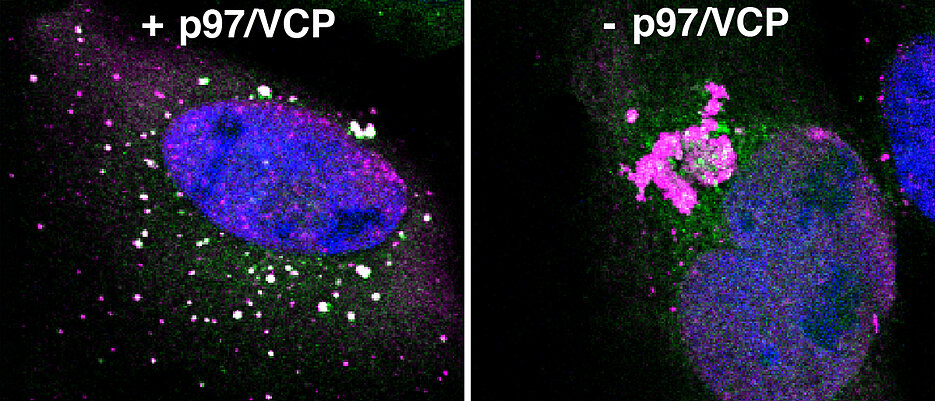When the cellular waste disposal system goes on strike, this can have fatal consequences. A research team at the University of Würzburg has now identified a key player in this clean-up crew.

A special enzyme - the so-called ubiquitin-selective unfoldase p97/VCP - is one of the main players when cells remove malformed or excess proteins from their interior. This is the central finding of a new study, the results of which have now been published in the journal Nature Communications.
The new findings form the basis for a better understanding of numerous pathological processes. They clearly show that blocking this enzyme causes proteins to fold incorrectly and form aggregates, which could play a role in neurodegenerative diseases such as Alzheimer's, Parkinson's and Huntington's disease.
A team led by biochemist Alexander Buchberger, Professor at the Biocenter of Julius-Maximilians-Universität Würzburg (JMU), is responsible for this study. Bettina Warscheid, also a professor at the JMU Biocenter, and J. Wade Harper from Harvard Medical School in Boston were also involved. The study was carried out as part of the Research Training Group 2243 "Understanding Ubiquitylation: From Molecular Mechanisms to Disease".
Complicated systems for controlling protein quality
The cells of most living organisms, including humans, are in principle tiny little protein factories. New proteins are constantly being produced inside them, assembled, transported to other locations and broken down again. It is very important that these processes are well balanced, as even small changes can lead to serious illnesses.
"To prevent this from happening, cells have developed complicated systems to control protein quality," explains Alexander Buchberger. For example, they can collect and isolate proteins that tend to clump together in a type of cage, known as an aggresome. They then break down these cages and their contents into parts and degrade them in various ways - a process known as aggrephagy in scientific jargon.
"While the formation of aggresomes has been studied in great detail, their protein content and degradation pathways have so far been insufficiently characterized," says the biochemist. The recently published study changes this. Buchberger and his team were able to prove that the breakdown of aggresomes requires several players. The most important of these proved to be the ubiquitin-selective unfoldase p97/VCP.
The experiments showed, among other things, that aggresomes no longer disintegrate and are destroyed if the researchers had previously blocked p97/VCP. "This indicates that the critical function of p97/VCP in the elimination of aggresomes is to break them down into smaller components," the group concluded.
Potential trigger of numerous diseases
The results are biomedically relevant in several respects: On the one hand, mutations in the p97/VCP enzyme cause neuro-muscular degenerative diseases, such as certain forms of dementia and ALS - amyotrophic lateral sclerosis. On the other hand, Parkinson's disease could also be the result of disrupted degradation processes inside the cell.
One of the hallmarks of Parkinson's disease are so-called Lewy bodies. These are roundish inclusions inside nerve cells that contain harmful protein deposits that disrupt the metabolism of nerve cells in the brain. They could also be degenerated aggresomes that are no longer broken down by the cell.
Accordingly, the research team concludes: "Our findings suggest that mutations in the enzyme p97/VCP disrupt the degradation of aggresomes. This could contribute to the formation of Lewy bodies and the development of neuro-muscular degenerative diseases."
Original publication
p97/VCP is required for piecemeal autophagy of aggresomes. Maria Körner, Paul Müller, Hirak Das, Felix Kraus, Timo Pfeuffer, Sven Spielhaupter, Silke Oeljeklaus, Christina Schülein-Völk, J. Wade Harper, Bettina Warscheid and Alexander Buchberger. Nature Communications.






